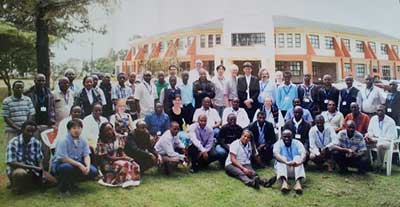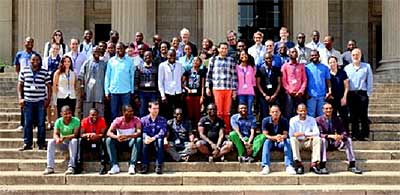Mentoring a Generation of Materials Scientists in Africa
George Amolo and Richard M. Martin
The development of science and technology in Africa is key to the attainment of socio-economic stability within the African society in the long term. However, there is a need to train sufficient manpower and set goals to attain such stability, an endeavor which should best be driven by the citizens of the continent with the support of foreign scientists and well-wishers.
A large number of well-trained materials scientists is likely to have direct or indirect impact in areas such as green energy production, water access and quality as well as food production, which are key to the needs of the African citizens. Materials science holds the possibility to have large impact in areas that take advantage of the rich resources in Africa: solar energy for electricity, new advanced materials processing of the mineral resources. The emergence of new and smart materials, which have wide varying applications from electronics, medical utility and the building industry, is also connected to fundamental studies in materials science. A number of international companies mining the vast mineral resources in Africa have their R&D sections in Europe and America, which is good for business but does not necessarily help to develop local capacity within the continent.
The African School on Electronic Structure Methods and Applications (ASESMA) focuses on materials science bringing to bear fundamental physics and chemistry [1, 2, 3] to address real problems in science and technology. The current knowledge of electronic structure methods and techniques has already contributed to the biological sciences in fields such as drug design and delivery. With the emerging smaller, less costly and powerful computers and computer clusters, electronic structure codes have been developed by experts to simulate real materials from fundamental science. In some cases, the state-of-the-art electronic structure codes are now not only capable of reproducing properties of materials that are close to independently verified experimental data but also have predictive capability. It is expected that the ongoing series of the ASESMA will enhance the capacity of materials scientists and hence turn the tide leading to the establishment of high level R&D units in Africa.
The first activity related to electronic structure studies was held at the African Institute of Mathematical Sciences (AIMS), Cape Town, South Africa in 2008. There were students from many countries in Africa. The goal of these activities is to grow the area of computational materials science among the younger generation of upcoming graduate students and researchers in the African continent. The next activity, held in 2010 also at AIMS in Cape Town, inaugurated the ASESMA series [4] intended to be held biannually in various African countries until the year 2020. ASESMA is endorsed by the International Union for Pure and Applied Physics (IUPAP) and has received massive support from donors and experts around the world. The second series of the ASESMA was held in Chepkoilel University College, now University of Eldoret, in Eldoret, western Kenya [see Figure 1]. The series held in Eldoret, like the first one, also witnessed a large number of experts, tutors and mentors from Europe, America and Asia coming out to support training of African participants in this field.

Figure 1: Group photo of the ASESMA in Eldoret, Kenya.

Figure 2: Group photo of the ASESMA in Wits, South Africa.
ASESMA 2015. The ASESMA was held in the University of the Witwatersrand (Wits), Johannesburg, South Africa at the end of January. Wits is a top African university with an excellent research reputation in science and technology. There were 41 participants in ASESMA 2015 from 10 different African countries [see photo in Figure 2] out of more than 250 applications.
This time the ASESMA was reorganized to accommodate both new participants as well as those who have some previous experience on electronic structure calculations, with the aim of taking the latter group to the next level of understanding and capability. These two groups attended common introductory lectures but different hands-on tutorials supported by tutors and mentors from Europe, America, Asia and Africa. Lectures and small groups were designed to give students the basic knowledge to understand what is done in the computations. In the tutorial sessions the participants were provided with PCs loaded with several open source codes such as Quantum Espresso [5], YAMBO [6] and Casino [7]. The tutorials on the PC are meant to help prepare input files for further intensive calculations in the supercomputer at the Centre for High Performance Computing (CHPC, Cape Town), which has offered generous support to the previous series of the ASESMA. The CHPC was kind enough to provide 40 dedicated nodes for a whole week for the ASESMA hands-on tutorials.
The ASESMA theme was this time focused on the optical properties of materials with lectures in the morning and hands-on tutorials in the afternoon during the first week. The second week was mainly set aside for projects, allowing the participants an opportunity to put into practice techniques learned the previous week. In the evenings, light lectures on selected topics in the areas of surface science, catalysis, pedagogy of electronic structure calculations were presented to the participants. Other topics covered in the evenings included the areas of women in science, the need for an African network in the field of materials science as well as skills necessary for hunting PhD and postdoctoral opportunities.
Success stories. Several participants, inspired by the ongoing series of the ASESMA, went ahead to register for graduate studies at the MSc and PhD levels and many are now in permanent positions. These are tangible outputs of the efforts invested in the ASESMA. As examples, Kingsley Obodo from Nigeria, registered for a PhD at the University of Pretoria, graduated in 2014 and is now a Research Officer at Johnson Mattey in South Africa. Mohammed Suleiman from Sudan was a PhD student at Wits and now holds a faculty position in University of Sudan, Khartoum, Sudan. George Manyali from Kenya is a postdoctoral fellow at Wits following his graduation with a PhD.
Sponsors of ASESMA. International Union for Pure and Applied Physics (IUPAP), US Liaison Committee for IUPAP, International Centre for Theoretical Physics (ICTP), The South African National Institute for Theoretical Physics (NITheP), The Thomas Young Centre, and the Centre for Doctoral Training on Theory and Simulation of Materials (TSM) - Imperial College London, Swiss National Center for Computational Design and Discovery of Novel Materials (NCCR MARVEL), Centre for High Performance Computing (CHPC) in Cape Town, DST-NRF (Department of Science and Technology, Republic of South Africa, and the National Research Foundation) Centre of Excellence in Strong Materials (COE-SM), Materials for Energy Research Group (MERG), University of the Witwatersrand, Centre for Research on Adaptive Nanostructures & Nanodevices (CRANN), Trinity College Dublin.
Future Plans. The lectures and tutorials that the participants go through during the ASESMA sessions prepares them for much more than can be accomplished in the two weeks period of the activity. It is important for the participants to continue with the projects and assignments when they get back to their home countries. The participants are encouraged to contact the tutors, mentors and lecturers via email to seek clarification and answers to what do they do not understand. To combat isolation of graduate students and young researchers in this field there have been plans to create an African network on computational materials sciences to complement the efforts of the ASESMA. One of the aims of the network is to keep contact with the current and previous participants of the ASESMA and others in the research community. It is expected that this network will help reach out to many more upcoming graduate students while supporting those currently trying to get experience in this field.
References
[1] Hohenberg, P. and Kohn, W. Phys. Rev. B 136, 864 – 871 (1964).
[2] Kohn, W. and Sham, L. J. Phys. Rev. A 140, 1133-1138 (1965).
[3] Car, R. and Parrinello, M. Phys. Rev. Lett. 55, 2471-2474 (1985).
[4] Chetty N, Martin R M, and Scandolo S. Nature 6, 830-832 (2010).
[5] Giannozzi, P. et al, J. Phys. Condens. Matter 21, 395502 (2009).
[6] Marini, A. et al, Comp. Phys. Comm. 180, 1392 (2009).
[7] Needs, R. J. et al, J. Phys.: Condens. Matter 22, 023201 (2010).
George Amolo is vice president of the Physics Society of Kenya and is in the Department of Physics, University of Eldoret, Eldoret 1125-30100, Kenya; Richard M. Martin chairs the International Advisory Panel for the ASESMA, and is emeritus professor of physics at the University of Illinois at Urbana-Champaign, Urbana, Illinois 61801-3080, USA. Email: amolo@uoeld.ac.ke
Disclaimer - The articles and opinion pieces found in this issue of the APS Forum on International Physics Newsletter are not peer refereed and represent solely the views of the authors and not necessarily the views of the APS.
